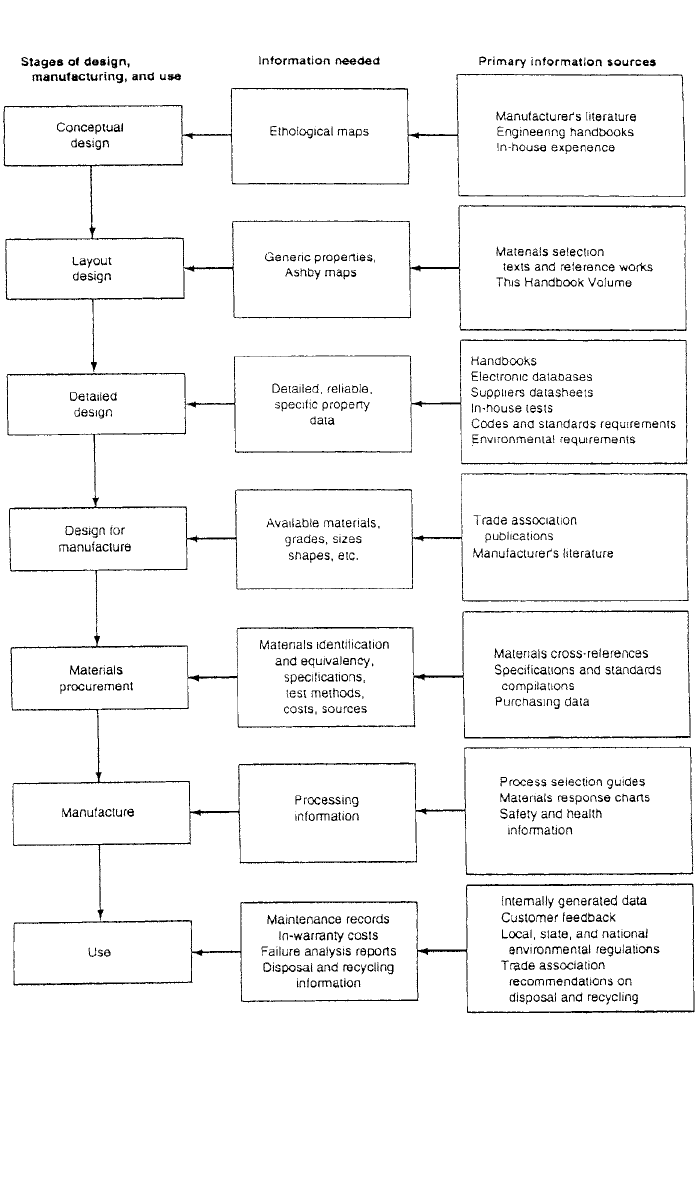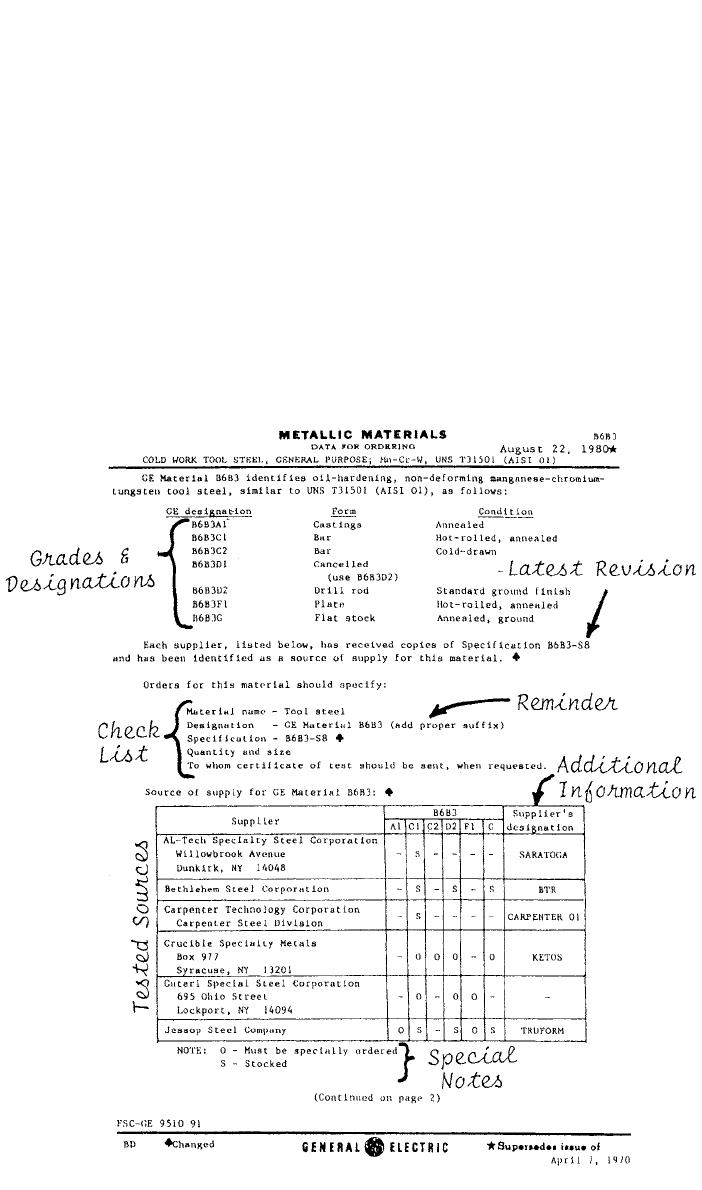Kutz M. Handbook of materials selection
Подождите немного. Документ загружается.


506 INFORMATION FOR MATERIALS PROCUREMENT AND DISPOSAL
Fig. 1 Information needs and sources at various steps in the design–manufacture–use cycle.
4

2 PROCUREMENT INFORMATION 507
identified, who are the leading producers and their addresses, in what unit quan-
tities is it sold, to what specifications or standards must it conform, etc. To
answer the first question, the agent must know the most common designation
for the material—international, national, trade association, or other—and its
equivalence in other designation systems. Various directories and cross-reference
guides have been developed for this purpose, a summary of which is provided
in Section 3. A typical example of a family of equivalents is shown in Table 1.
Nominal equivalence, as set forth in a cross-referencing table or by chemical
composition as in Table 1, may not suffice. Thus any material offered by a
prospective supplier, whose specification is not explicitly that called for by the
design engineer, should be tested for critical properties and a sign-off obtained
from engineering prior to purchase. The sources cited in Section 3 are primarily
cross-reference guides and seldom offer more than a brief summary of a spec-
ification. Therefore, to assist the engineer in determining the equivalence or
acceptability of the material in question, resort must be made to the full speci-
fication for the material. These may be obtained from the issuing body—
International Organization for Standards (ISO), American National Standards
Institute (ANSI), American Society for Testing and Materials (ASTM),
Deutsches Institut fu¨r Normung (DIN), British Standards Organization (BSO),
etc. Conveniently, a very comprehensive collection of standards and specifica-
tions of all types is maintained by Information Handling Services, Englewood,
Colorado, which can provide printed copies of any selected specification for a
nominal charge.
The purchasing agent should work with the engineer to secure the most cost-
effective material. In particular, effort should be made by a company to avoid
‘‘specials’’ and to try whenever possible to adopt a standard or specification
already established by an organization at a higher hierarchical level, that is, a
trade association, professional association, or national or international standard.
Whenever necessary to be included in a specification, the test method or quan-
titative inspection technique cited should be one recognized nationally, for ex-
ample, an ASTM standard. The subject of standards and specifications for
materials has been discussed by Westbrook.
2
Materials Sources. Having identified the material needed and the specifi-
cation(s) governing its properties, the purchasing agent must consider possible
sources from which it might be obtained. These should include both sources
local to the plant of the procuring organization, national sources, and interna-
tional sources. Whether or not a given vendor is a viable source will depend on
stocking policies, delivery schedules, price, etc. Economic aspects are discussed
below under costs. General guides to materials sourcing are as follows:
Sources of Materials Purchasing Information
American Metal Market (5 issues per week) Fairchild, NY
Basil, D. C., et al., eds., Purchasing Information Sources, Gale Research,
Detroit MI, 1977, 256 pp.
Bittence, J. C., ed., Guide to Engineering Materials Producers, ASM Inter-
national, Metals Park, OH, 1993, 392 pp.
Brady, G. S., Clauser, H. R., and Vaccari, J. A., Materials Handbook: An
Encyclopedia for Managers, Technical Professionals, Purchasing and Pro-

508
Table 1 Example of Chemical Composition Comparison of U.S., International, and Foreign Specifications for a Given Material (305 Stainless Steel)
1
Nation Agency Designation (Alternate)* C Si Mn Cr Ni Mo Others
USA
International
USA Society
USA Society
USA Society
UNS
ISO
AMS
AMS
ASTM
S30500 (AISI 305)
683 / XIII Type 13
5514 (p, sh, st)
5685 (w); 5686 (w)
A193 (bolt), A320 (pipe), A240 ( p, sh, st), A276 (b, shp),
A313 (w), A314 (b, bl ), A368 (w), A473 ( ƒ ), A478 (w),
A492 (w), A493 (b, w), A511 (t), A554 (t), A580 (w)
UNS S30500
0.12
0.10
0.12
0.08
0.12
1.00
1.00
1.00
1.00
1.00
2.00
2.00
2.00
2.00
2.00
17.00–19.00
17.00–19.00
17.00–19.00
17.00–19.00
17.00–19.00
10.00–13.00
11.00–13.00
10.00–13.00
10.00–13.00
10.50–13.00
—
0.75
0.75
0.75 Cu
0.75 Cu
USA Society
USA Government
USA Government
USA Company
SAE
FEDERAL
FEDERAL
GE-EMPIS
J405 30305
QQ-S-763 305 (b, f, w)
QQ-S-766 305 ( p, sh, st)
B7A39 (w); B7A41 (sh, st)
0.12
0.12
0.12
0.12
1.00
1.00
1.00
1.00
2.00
2.00
2.00
2.00
17.00–19.00
17.00–19.00
17.00–min
17.00–19.00
10.50–13.00
10.00–13.00
10.00–13.00
10.00–13.00
—
0.75
—
—
0.75 Cu
Bulgaria
France
France
Germany, Dem R.
Germany, Fed R.
Germany, Fed R.
Italy
BDS
AFNOR NF
AFNOR NF
TGL
DIN Stoff Nr
DIN Stoff Nr
UNI
9631 Ch18N9L
A35-575, -577; ZBCN18.12; A35-586 305F00
Z10CN18.9M
14394 GS-X12CrNi18, 9
1.4303,X5CrNi18 12 (X5CrNi19, 11)
1.4312, G-X10CrNi18, 8
AIP XBCrNi19, 10
0.15
0.10
0.12
0.15
0.07
0.12
0.08
1.50
1.00
2.00
1.50
1.00
2.00
1.50
2.00
2.00
1.50
2.00
2.00
1.50
1.00
17.00–19.00
17.00–19.00
17.00–19.50
17.00–19.00
17.00–19.00
17.00–19.50
18.00 nom.
8.00–11.00
11.00–13.00
8.00–10.00
8.00–10.00
11.00–13.00
8.00–10.00
12.00 nom.
—
—
—
—
—
—
—
Japan
Japan
Mexico
Mexico
PRC China
JIS
JIS
DGN
DGN
GB
G4303; G4304; G4305; G4308; G4309; G4315;
G4318 SUS305 (SUS62HP, CP, WR)
G4308; G4309; G4315; G4318 SUS305J1
B-171 Grade MT305; B-218 Grade TP305
B-83 305
1220 1Cr18Ni12; 3280 1Cr18Ni12
0.12
0.08
0.12
0.12
0.12
1.00
1.00
1.00
1.00
1.00
1.00
2.00
2.00
2.00
2.00
2.00
17.00–19.00
16.50–19.00
17.00–19.00
17.00–19.00
17.00–19.00
10.50–13.00
11.00–13.50
10.00–13.00
10.50–13.00
10.50–13.00
—
—
—
—
—
Rumania
Spain
United Kingdom
United Kingdom
USSR Russia
USSR Russia
STAS
UNE
B.S.
B.S.
GOST
GOST
6855 T12MSNC180
36-016 F.3513 XBCrNi18-12 E-305
1449 305S19
3111 305S17
06Ch18N11
10Ch18N9L
0.15
0.10
0.10
0.07
0.06
0.07–0.14
0.50–0.20
1.00
1.00
1.00
0.80
0.20–1.00
2.00
2.00
2.00
2.00
2.00
1.00–2.00
17.00–19.00
17.00–19.00
17.00–19.00
17.00–19.00
17.00–19.00
17.00–20.00
8.00–10.00
11.00–13.00
11.00–13.00
11.00–13.00
10.00–12.00
8.00–11.00
—
—
—
—
.30
—
0.30 Cu, 0.20 W, 0.20 Ti
0.30 Cu
* b ⫽ bar, bl ⫽ billet, ƒ ⫽ forging, p ⫽ plate, sh ⫽ sheet, shp ⫽ shape, st ⫽ strip, t ⫽ tube, w ⫽ wire.

2 PROCUREMENT INFORMATION 509
duction Managers, Technicians, and Supervisors, 14th ed., McGraw-Hill,
New York, 1996, 1072 pp.
Cavinato, J. L. and Kauffman, R. G., eds., The Purchasing Handbook, 6th ed.
McGraw-Hill, New York, 1999, 1082 pp.
Ceramic Sources (annual), American Ceramic Society, Westerville, OH
Chemical Economics Handbook, Stanford Research Institute, Palo Alto, CA,
1982–1984
Cost Reduction Strategies, NAPM Resource Guide, NAPM, P.O. Box 22160,
Tempe, AZ 85285-2160 (NAPM is now the Institute for Supply Manage-
ment)
Frick, J., ed., Woldman’s Engineering Alloys, 9th ed., ASM International Met-
als Park, OH, 2001, 1400 pp.
Global Sourcing, NAPM Resource Guide, NAPM, P.O. Box 22160, Tempe,
AZ 85285-2160 (NAPM is now the Institute for Supply Management)
Grant, A. H., A Guide to Buying Castings, State Mutual, NY
Heinritz, S. F., et al., eds., Purchasing: Principles and Applications, 8th ed.,
Prentice Hall, Upper Saddle River, NJ, 1991, 580 pp.
Leenders, M. R. and Fearon, H. E., eds., Purchasing and Materials Manage-
ment, 10th ed., Irwin, Homewood, NJ, 1992
Locke, D., Global Supply Management: A Guide to International Purchasing,
McGraw-Hill, New York, 1996, 300 pp.
Product Sources (annual), R&D Magazine, Cahners, Newton, MA
National Association of Purchasing Managers (now the Institute for Supply
Management), Suppliers Directory, NAPM P.O. 22160, Tempe, AZ 85285-
2160
Roskill’s Metals Databook, 7th ed., TMS-AIME, Prices, production and pro-
ducers of 32 metals worldwide
Roskill Reports. Prices, trends, demand, uses, etc. for 70 commodities (metals,
minerals, inorganics, bromine, etc.) TMS-AIME, updated regularly
Serjeanson, R., ed., Metal Bulletin’s Prices and Data, 6th ed., Metal Bulletin
Journals, Ltd., Worcester Park, UK, 1982, 423 pp.
Westbrook, J. H. and Reynard, K., ‘‘Data Sources for Materials Economics,
Policy, and Management,’’ in Concise Encyclopedia of Materials Econom-
ics, Policy, and Management, M. B. Bever, ed., Pergamon Press, 1993, pp.
35–43
Costs. Actual costs of a procured material are determined by interaction
between the purchasing agent and the supplying vendor. These are not neces-
sarily fixed and neatly listed in the supplier’s catalog but may depend on a
number of factors of which the purchaser should be aware. These include: Is
the material regularly stocked or only available on special order; is price affected
by size, shape, or surface finish; are there quantity discounts or order quantity
minima; what are the normal delivery schedules; are there particular features
required that the vendor company would regard as ‘‘specials’’; etc. General in-
formation about material costs and price trends may be found in the sources

510 INFORMATION FOR MATERIALS PROCUREMENT AND DISPOSAL
Fig. 2 Typical data for ordering sheet.
3
given above, particularly, American Metal Market, Chemical Economics Hand-
book, the Roskill Metals Databook and Reports, and the Serjeanson book.
One Company’s Reduction to Practice. For more than 70 years the General
Electric Company has had a formalized, comprehensive, reference system for
the materials information needed in its diverse manufacturing operations. This
system is known as EMPIS, an acronym for Engineering Materials and Processes
Information Service, and is organized in a tripartite structure, sometimes referred
to as the three legs of the materials information stool: engineering properties,
specifications, and data for ordering. A fuller description is provided by West-
brook.
3
The part that is relevant here is the Data for Ordering section.
A typical page for a single material among the more than 25,000 materials
covered in GE’s EMPIS system is shown in Fig. 2. In addition to the EMPIS
material number, title, and scope and designation sections, which are similar to

3 DIRECTORIES AND CROSS REFERENCES TO MATERIALS 511
the corresponding sections of the specification document, the Data for Ordering
sheet contains a checklist, a reference to applicable documents, a list of tested
sources of supply for each of the various grades covered by the specification,
and when applicable the appropriate supplier’s designation for the product. (The
supplier’s designations are not a part of the specification but are included on the
Data for Ordering sheet as clarifying information).
A checklist is provided that tells the buyer at a glance exactly what must be
written on the purchase order and what documents are to be included with the
order to completely define the desired material. The list of suppliers provided
includes only those that have previously delivered conforming material to the
General Electric Company and are added to the list at the request of operating
components of the company that testify to compliance. To this extent they are
treated as sources of supply. However, the list is not to be construed as an
‘‘approved’’ list of suppliers, nor as an all-inclusive list. Buyers are encouraged
to develop additional sources of supply—particularly for critical or large volume
applications—and to report satisfactory experience for subsequent addition to
the list of suppliers. Each supplier listed on the Data for Ordering sheet is placed
on an automatic distribution list and receives updated copies of each specification
for which the supplier is listed. Therefore, when buying from a listed supplier,
it is not normally required that a copy of the specification accompany the order.
In many cases the Data for Ordering sheet contains special notes, hints, and
suggestions for facilitating procurement, minimizing costs, and standardizing
sizes and lots. These are of many different kinds but include, for example, sizes
stocked by listed suppliers, cost information, minimum order quantities, delivery
schedules, features that represent ‘‘specials,’’ etc.
3 DIRECTORIES AND CROSS REFERENCES TO MATERIALS
STANDARDS AND SPECIFICATIONS*
(C) Alloy Finder CD-ROM, 2nd ed., ASM International, Metals Park, OH.
Incorporates Woldman’s Engineering Alloys, 8th ed., 1994; Worldwide
Guide to Equivalent Irons and Steels, 3rd ed., 1993; and Worldwide Guide
to Equivalent Nonferrous Metals and Alloys, 3rd ed., 1996.
(P/C) Worldwide Guide to Equivalent Irons and Steels, 4th ed., ASM Inter-
national, Metals Park, OH, 2000. Available in print (1132 pp.) and on CD-
ROM; data from a prior edition also included in Alloy Finder CD-ROM
(see separate listing).
(P/C) Worldwide Guide to Equivalent Nonferrous metals and Alloys, 3rd ed.,
W. Mack, ed., ASM International, Metals Park, OH, 1995. Available in
print and on diskette; data also included in Alloy Finder CD-ROM (see
separate listing).
(P) Frick, J. P. ed., Woldman’s Engineering Alloys, 9th ed., ASM International,
Metals Park, OH, 2001. Lists compositions, selected properties, and man-
*C⫽ computer-readable, P ⫽ print, P / C ⫽ both.

512 INFORMATION FOR MATERIALS PROCUREMENT AND DISPOSAL
ufacturers for 53,000 alloys. Available in print and on diskette; data from
prior edition also included in Alloy Finder CD-ROM (see separate listing).
(P) British and Foreign Specifications for Steel Castings, Steel Casting Re-
search and Trade Association, Sheffield, UK, 1980.
(P) Department of Defense Index of Specifications and Standards, Part 1,
Alphabetical Listing; Part 2, Numerical Listing, U.S. GPO (annual).
(C) EQUIST for Windows, M. Gorglay, ed. Hungarian database of standard
steels with comparisons and equivalencies for 13,000 standard steels from
18 countries, 1998.
(P) Index of Standards, European Committee for Iron and Steel Standardi-
zation (ECISS), PSP2, British Steel, plc, Head Office Standards, London,
UK 1986.
(P) German Standards, Beuth, Germany. English translation of more than
4750 popular DIN standards plus 1500 DIN-EN, DIN-EC, and DIN-ISO
standards.
(C) Global Standards Network. A directory on the World Wide Web of
⬎100,000 regional, national, and international standards, produced by
ANSI and NIST (http:/ /www.nssn.org).
(P) Handbook of Comparative World Steel Standards, DS 67, ASTM, 1996,
552 pp.
(P) Handbook of International Alloy Compositions and Designations, Vol. 1R,
Titanium, Metals and Ceramics Information Center, Battelle Columbus
Laboratories, 1990.
(P) Hufnagel, W., ed., Key to Aluminium, 4th ed., Aluminium AG, Dusseldorf,
Germany, 1991.
(P) SAE Aerospace Standards Index, Society of Automotive Engineers, 2000.
(P) Iron and Steel Specifications, 7th ed., British Steel, London, UK, 1989,
346 pp. Steel grades to BS970 together with French, German, Japanese,
and Swedish standards.
(P) ISR/VAMAS Unified Classification Scheme for Advanced Ceramics,
ASTM, 1993.
(P) Kehler, M., Aluminium, Vol. 3, Handbook of International Alloy Com-
positions and Designations, Aluminium Verlag, Heyden, Germany, 1981,
859 pp.
(P) Materials, Vol. 4, World Standards Speedy Finder, The International Tech-
nical Information Institute of Japan, Tokyo.
(C) Materials Infobase. A database covering tens of thousands of nonmetallic
materials, products, suppliers, and standards. Regularly updated. Available
on CD-ROM, magnetic tape, and World Wide Web (www.idi.co.uk).
(C) Metals Infobase. A CD-ROM database integrating data on tens of
thousands of metal grades, over 5000 worldwide standards, a directory of
leading suppliers, and limited property information. Also accessible via a
web site (www.ili-info.com) ILI Infodisk, Inc., Paramus, NJ.
(P) Metals and Alloys in the Unified Numbering System, 8th ed., DS 56F,
ASTM 1999, 477 pp.

4 MATERIALS DISPOSAL 513
(P/C) New Trade Names in the Rubber and Plastics Industry, RAPRA Tech-
nology, Ltd., Shropshire, UK. 53,000 trade names with product description
and suppliers’ names and addresses, available in both print and CD-ROM.
(P/C) Potts, D. L. and Gensure, J. G., International Metallic Materials Cross-
Reference, 3rd ed., Genium Publishing Co., Amsterdam, NY, 1988, print
(699 pp) and diskette.
(P) Reynard, K. W, ed., Inventory of Materials Designation Systems, Ver-
sailles Advanced Materials and Standards (a project of TWA-10), National
Physical Laboratory, Teddington, UK.
(P) Ricci, P. L. and Perry, L., Standards: A Resource and Guide for Identi-
fication, Selection, and Acquisition, Stirz, Minneapolis, MN, 1991.
(P) Ross, R. B., ed., Metallic Materials Specifications Handbook, 4th ed.,
Chapman and Hall, 1992, 830 pp.
(P/C) Schmitz, H., Stahl-Eisen-Listen/Steel-Iron Lists, 7th ed., VDEh, Dus-
seldorf, Germany, 1987. 2500 German and 1000 foreign materials covered;
also in a computerized database.
(P/C) Stahlschlu¨ssel (Key to Steel), 18th ed., Verlag Stahlschlu¨ssel, 1998,
print (685 pp) and CD-ROM. Trilingual: English, French, and German.
(C) Standards Infobase. A database covering
⬎360,000 U.S. and foreign stan-
dards issued by U.S., international, and European organizations. ILI Info-
disk, Paramus, NJ (see: www.ili-info.com).
(P) Supplement to Dechema Corosion Handbook–Concordance of U.S. and
German Designations for Metallic Materials, VCH, Weinheim, Germany,
1992, 254 pp.
(P) Technical Data. Technical Indexes, Ltd., Bracknall, UK, updated monthly.
Contains
⬎100 indexed microfilm or microfiche files covering 10 million
pp. of technical information. 1000 pp printed index.
(C) Traceski, F. T., Specifications and Standards for Plastics and Composites,
ASM International, Metals Park, OH, 1990, 224 pp.
(C) UNSearch, a computerized form of the book, Metals and Alloys in the
Unified Numbering System, ASTM/SAE, Philadelphia, PA.
(P) Wahl, M. J., Handbook of Superalloys, International Alloy Compositions
and Designations Series, Springer Verlag, Berlin, 1982, 258 pp.
(P) Woishnis, W. A., ed., Engineering Plastics and Composites, 2nd ed., ASM
International, Metals Park, OH, 1993, 590 pp. Identifies trade names and
manufacturer’s designations for polymeric materials.
(P) Wood, P., ed., International Trade-names Dictionary, Gale Research, De-
troit, MI, 1989.
(D) World Metal Index, Sheffield City Libraries, Sheffield, UK. A service
covering 70,000 standard grades of metallic materials worldwide.
4 MATERIALS DISPOSAL
Proper disposal and recycling of materials serves several different objectives:
conservation of resources, reduction of energy consumption, lowered materials
costs, and regulatory compliance [local, state, and national, e.g., Environmental

514 INFORMATION FOR MATERIALS PROCUREMENT AND DISPOSAL
Protection Agency (EPA) regulations]. Specific instances include the separation
of valuables, e.g., platinum from automotive emission controls, and the separa-
tion of hazardous or deleterious contaminating elements, e.g. Pb, Hg, Sn, and
Zn. Materials scrap is distinguished as to that resulting from obsolete or worn-
out product (obsolete scrap) and that internally generated during manufacturing
(prompt scrap), the latter being further broken down into that which is imme-
diately internally recycled (home scrap) and that which is input to the scrap
recycling industry (purchased scrap). Throughout all these movements of poten-
tially useful material, information is needed as to the form, composition, and
source of the scrap.
Some industries even produce scrap specifications; the iron and steel industry
alone has more than 20 such documents covering different grades of ferrous
scrap. To realize the highest value from scrap recovery and recycling, or to avoid
penalties from improper disposal, thorough identification is needed. This in turn
requires reference information on physical properties (color, density, hardness,
magnetic behavior, thermoelectric properties, spark characteristics, etc.) and
chemical properties (qualitative spot tests, quantitative chemical analyses, or
optical and X-ray spectroscopies). If the scrap cannot be explicitly defined as to
the particular material (alloy, solution, blend, etc.), then it will be used in a
downgrading operation, with lowered cost recovery and heightened possibility
of contamination. Some particular sources of information on materials disposal
and recycling are listed in Section 5. Other may be found in Refs. 4 and 5.
5 SOURCES OF INFORMATION FOR MATERIALS DISPOSAL AND
RECYCLING
Abert, J. G., ‘‘Resource Recovery: Economic and Institutional Aspects,’’ in Encyclopedia of Materials
Science and Engineering, M. B. Bever, Ed., Pergamon, Oxford, UK, 1986, pp. 4227–4231.
Campbell, J. A. and Russell, S. H., ‘‘Resource Recovery: Technology,’’ in Encyclopedia of Materials
Science and Engineering M. B. Bever, ed., Pergamon, Oxford, UK, 1986, pp. 4231–4238.
Dominguez, G. S. and Bartlett, K. G., Hazardous Waste Management, Vol. 1, CRC Press, Boca
Raton, FL, 1986.
Environmental Issues in Purchasing, NAPM Resource Guide, NAPM, P.O. Box 22160, Tempe, AZ
85285-2160.
Hawkins, W. L., ‘‘Recycling of Polymers,’’ in Encyclopedia of Materials Science and Engineering
M. B. Bever, ed., Pergamon, Oxford, UK, 1986, pp. 4127–4130.
Institute of Scrap Recycling Industries, Inc., 1325 G Street, NW, Washington, DC 20005. Tel (202)
455–4050.
Kaplan, R. S. and Ness, H., ‘‘Recycling of Metals: Technology,’’ in Encyclopedia of Materials Science
and Engineering, M. B. Bever, Ed., Pergamon, Oxford, UK, 1986, pp. 4114–4123.
Kreith, F., Handbook of Solid Waste Management, McGraw-Hill, New York, 1994.
Lory, F. W. and Martin, W. C., ‘‘Recycling of Paper Products,’’ in Encyclopedia of Materials Science
and Engineering, M. B. Bever, Ed., Pergamon, Oxford, UK, 1986, pp. 4123–4127.
Manser, T., Standard Handbook of Hazardous Waste Treatment and Disposal, 2nd ed., McGraw-Hill,
New York, 1989.
Manser, T., Practical Handbook of Processing and Recycling of Municipal Waste, CRC Press, Boca
Raton, FL, 1996.
National Recycling Coalition, Room 2350, Rockefeller Plaza, New York , NY, 10111.
National Resource Recovery Association, 1620 Eye Street NW, Washington, DC 20006. Tel. (202)
293–7330.
Neff, D. V., ‘‘Recycling of Nonferrous Metals,’’ in ASM Handbook, Vol. 2, 10th ed., ASM Interna-
tional, Metals Park, OH, 1990 pp. 11205–1232.

REFERENCES 515
Phillips, T. A., ‘‘Recycling of Iron, Steel, and Superalloys,’’ in ASM Handbook, Vol. 1, 10th ed.,
ASM International, Metals Park, OH, 1990, pp. 1023–1033.
Polydata GmbH (database of technical support for dismantling and recycling), Frankenbergerstrasse
30, D-5100, Aachen, Germany. Tel: 49 241 502 023.
Recycler’s World, Web site: www.recycle.net (a world-wide trading site for information on secondary
and recyclable commodities).
Rhyner, C., Waste Management and Resource Recovery, CRC Press, Boca Raton, FL, 1996.
Tchobanglous, G., Integrated Solid Waste Management—Engineering Principles and Management
Issues, 2nd ed., McGraw-Hill, New York, 1993.
Toxicology Data Network and Environmental Health Information Program, National Library of Med-
icine, Specialized Information Services Division, 8600 Rockville Pike, Bethesda, MD 20894.
Tel: (301) 496–6531.
Toxicology Information Center, Environmental Studies and Toxicology Board, National Academy of
Sciences, 2101 Constitution Avenue, NW, Washington, DC 20418. Tel: (202) 334–2387.
Yoder, B., The Recovery Resource Book, Fireside, New York, 1990.
6 CURRENT ISSUES
In Section 1 we mentioned some current issues placing new demands on infor-
mation. Globalization is one such issue. Today, not only are many materials
being sourced from overseas, but entire products or components thereof are
being manufactured overseas, but to American designs and specifications. The
need for information relative to equivalency of U.S. versus foreign materials test
methods, delivery schedules, etc., is obvious. Some relevant information sources
were included in Section 2. Others may be located through the International
Forum on Globalization
6
and other Websites.
7,8
A second factor is the growing use of so-called e-commerce: doing business
almost entirely electronically rather than via printed documents or interpersonal
information exchange. The extent of the use of e-commerce varies between
fields, but current estimates are from 20–50% of all business conducted in nearly
all fields and growing rapidly. This circumstance does not alter the kind or
amount of material information needed but puts new demands on its currency
and places enhanced emphasis on information already in electronic form.
9–11
Finally, another current trend is that of ‘‘just-in-time’’ logistics manage-
ment.
12–15
By this term is meant that the materials purchaser chooses not to buy
and store materials at his plant until needed by manufacturing operations but
rather contracts with one or more vendors to deliver a needed material on a
continuing basis, obviating on-site storage and its associated costs, and feeding
that material immediately upon receipt into the manufacturing operation. Again
the associated information is not different in kind from that needed for traditional
manufacturing, but new emphasis is placed on currency and intimate mutual
understanding of information exchanged between vendor and manufacturer.
REFERENCES
1. D. L. Potts, and J. G. Gensure, International Metallic Materials Cross-Reference, 3rd ed., Genium
Publishing Corp., Amsterdam, NY, 1988, print 699 pp., and diskette.
2. J. H. Westbrook, ‘‘Materials Standards and Specifications,’’ in Kirk-Othmer Encyclopedia of
Chemical Technology, Vol. 16, 4th ed., 1995, pp. 33–67.
3. J. H. Westbrook, ‘‘EMPIS: A Materials Data Program of an Electrical Manufacturing Company,’’
Proc. of 7th Int’l. CODATA Conf., Oct. 1980, Kyoto, Japan, Pergamon, 1981, p. 412.
4. J. H. Westbrook, ‘‘Sources of Materials Property Data and Information,’’ in ASM Handbook, Vol.
20, Materials Selection and Design, ASM International, Metals Park, OH, 1997, pp. 491–506.
